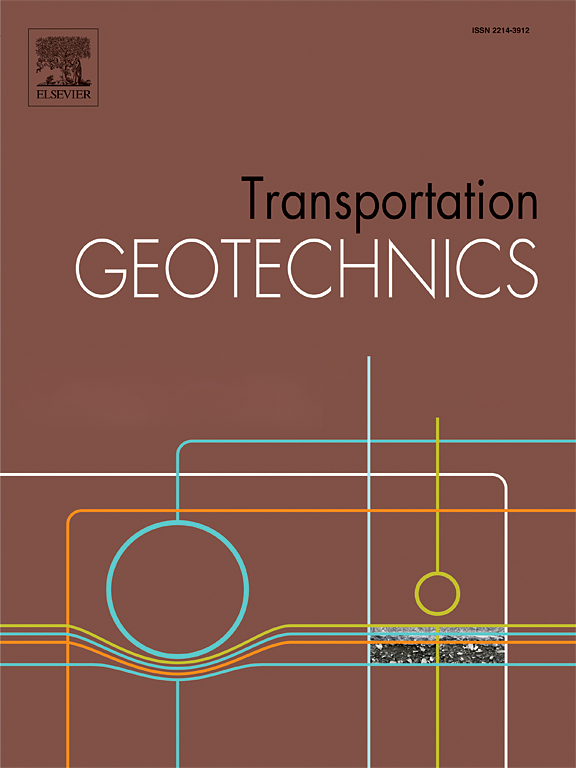Estimation of unsaturated small-strain shear modulus in a laboratory test box and field site from a soil-water characteristic curve
IF 4.9
2区 工程技术
Q1 ENGINEERING, CIVIL
引用次数: 0
Abstract
The small-strain shear modulus plays a significant role in analyzing soil-structure interactions and the stiffness properties of earth materials under static and dynamic loading conditions. Traditionally, this parameter is determined through seismic wave measurements in the laboratory and in the field. Alternatively, it can be determined in the field by performing dynamic cone penetrometer tests and subsequently converting to California Bearing Ratio (CBR) values using empirical equations, and finally to modulus using another empirical equation. However, this multistep process is both labor-intensive and prone to compounded errors stemming from the use of numerous empirical relationships. In this study, an approach was introduced for estimating the small-strain shear modulus for preliminary analysis based on the soil–water characteristic curve (SWCC) and a saturated small-strain shear modulus. The proposed model, developed using laboratory small-strain shear modulus data, was tested on soils compacted within a laboratory test box. In addition, a correlation was derived from the test box to modify the proposed model to make it applicable to field soils. The modified model was applied to a field site to predict measured small-strain shear modulus, which was determined from shear wave velocity and SWCC fitting parameters derived from textural characteristics and electrical resistivity. The predicted data showed satisfactory agreement with the measured data at the field site. Overall, the study demonstrates the effectiveness of the proposed model in predicting small-strain shear modulus for both small laboratory specimens and field data.
基于土-水特征曲线的室内试验箱和现场非饱和小应变剪切模量估算
小应变剪切模量对于分析静、动荷载作用下土-结构相互作用和土材料刚度特性具有重要意义。传统上,这个参数是通过实验室和现场的地震波测量来确定的。另外,也可以在现场进行动态锥贯仪测试,然后使用经验方程将其转换为加州承载比(CBR)值,最后使用另一个经验方程将其转换为模量。然而,这个多步骤的过程是劳动密集型的,而且由于使用了大量的经验关系,容易产生复合错误。本文提出了一种基于土-水特征曲线(SWCC)和饱和小应变剪切模量的初步分析小应变剪切模量估算方法。所提出的模型是利用实验室小应变剪切模量数据开发的,并在实验室试验箱内进行了土壤压实试验。此外,从试验箱中导出了一个相关性,以修改所提出的模型,使其适用于现场土壤。将修正后的模型应用于现场,通过剪切波速和基于纹理特征和电阻率的SWCC拟合参数来预测实测的小应变剪切模量。预测数据与现场实测数据吻合较好。总的来说,该研究证明了所提出的模型在预测小应变剪切模量方面的有效性,无论是小型实验室样本还是现场数据。
本文章由计算机程序翻译,如有差异,请以英文原文为准。
求助全文
约1分钟内获得全文
求助全文
来源期刊

Transportation Geotechnics
Social Sciences-Transportation
CiteScore
8.10
自引率
11.30%
发文量
194
审稿时长
51 days
期刊介绍:
Transportation Geotechnics is a journal dedicated to publishing high-quality, theoretical, and applied papers that cover all facets of geotechnics for transportation infrastructure such as roads, highways, railways, underground railways, airfields, and waterways. The journal places a special emphasis on case studies that present original work relevant to the sustainable construction of transportation infrastructure. The scope of topics it addresses includes the geotechnical properties of geomaterials for sustainable and rational design and construction, the behavior of compacted and stabilized geomaterials, the use of geosynthetics and reinforcement in constructed layers and interlayers, ground improvement and slope stability for transportation infrastructures, compaction technology and management, maintenance technology, the impact of climate, embankments for highways and high-speed trains, transition zones, dredging, underwater geotechnics for infrastructure purposes, and the modeling of multi-layered structures and supporting ground under dynamic and repeated loads.
 求助内容:
求助内容: 应助结果提醒方式:
应助结果提醒方式:


